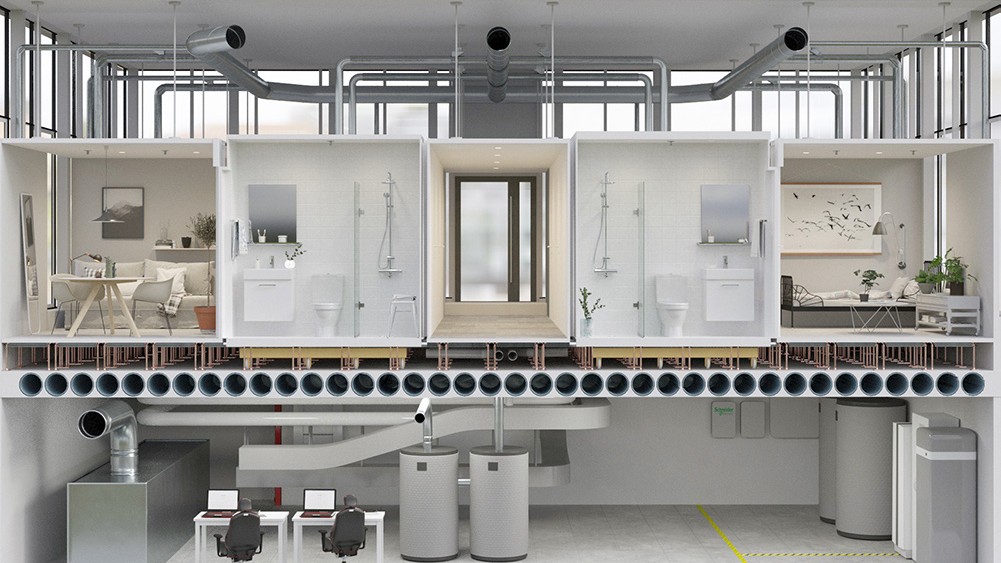Distributed Sensing Lab – Collaboration between KTH and High schools
The project aims to increase knowledge and understanding of resources and buildings. By involving high school students in technology programs and collecting data from different buildings around Sweden, a national resource directory can be created, which, in turn, could generate insights about buildings.

Background
This project is based on a collaboration with high schools. KTH Royal Institute of Technology plans to develop a sensor kit that students in The Technology Program (“Teknikprogrammet”) can explore and further develop. Students will also have the opportunity to bring home boxes with different sensors, and KTH Live-in Lab (LIL) will try to arrange a data transfer to their own database. Data that is generated can thereby be used by both LIL and in the high school courses Teknik 1 and Teknik 2, with the aim of creating a connection to what is going on in our homes, and creating commitment around resources and our way of life. Such authentic learning is also expected to increase students' interest in further education in technology.
Project description
Within this project, a number of sub-projects will be carried out.
The education part
As part of the entire project, we will carry out a sub-project in research and development aimed at teaching within The Technology Program. This teaching part aims to develop a working material that relates to the mentioned sensor kits and boxes. In addition, the teaching part aims to examine students' learning, in connection with them working with the material.
When teaching is strongly linked to reality, so-called authentic learning can develop (Herrington & Oliver, 2000; Hill & Smith, 2005; Herrington, Reeves & Oliver, 2010). This relates to goals and abilities in syllabi but also to more general goals and abilities in the field of engineering, for example to the CDIO abilities (Conceive – Design – Implement – Operate) (Crawley, Malmqvist, Lucas & Brodeur, 2011). A CDIO-based framework is about training in an engineering approach. CDIO is not explicitly stated in the degree objectives for The Technology Program, but since the program's purpose is to lead to eligibility for higher education in the technical sector, the approach is found implicitly (The Swedish National Agency for Education, 2021).
The Swedish National Agency for Education writes (LIL translation): “In order to develop engineering professionalism, basic knowledge in mathematics, natural, technical and engineering sciences is needed. In addition, a systems thinking is needed to understand the interplay between different parts of a system and its significance for the whole. The engineer must develop an ability to develop technical solutions to small and large problems. An engineer needs to be critically curious, good at communicating and collaborating in various forms, as well as having knowledge of leadership and group processes. In the work process, a number of external perspectives must also be considered, such as the user's needs, the business conditions, ethics and a sustainable society.”
The syllabi for the Technology 1 and Technology 2 courses include both breadth and depth within a rich content. Energy issues can be related to a large part of the content. The working material that is to be developed within the framework of the project will be based on the syllabi in terms of abilities and content. Another starting point is the sensor kit and the box that KTH Royal Institute of Technology will develop and provide to the students. They will be able to work with and further develop the sensor kit, analyze and evaluate the data material, and they will be able to relate their reflections and knowledge to energy facts and the 17 Sustainable Development Goals (Swedish Energy Agency, 2021; CETIS, 2021; 2030 Agenda for Sustainable Development).
Once the working material has been adapted and initiated in a class, we will examine the students' learning. Through surveys and interviews as a data collection method, we will learn about the students' descriptions and interpretations. Then we will analyze the data thematically and relate it to previous research on, among other things, authentic learning, but also to technical knowledge that is important for the Sustainable Development Goals. This sub-project therefore also includes a survey process that can be used in several classes when the working material is more widely distributed.
An expected result is that data from all over Sweden is made available and that students’ interest in universities, and research and development, increases.
Implementation
In the first phase, we plan to produce the working material together with Vattenfallsgymnasiet in Forsmark. The plan is to include both Technology 1 and Technology 2 courses.
The first stage of development in 2021 will include meetings with key people at Vattenfallsgymnasiet about the design and contents of the working material, how the working material can be involved in the courses, which activities are relevant, and time and resource planning.
